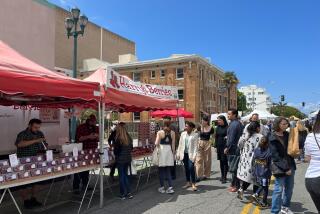Altered Bacterium Does Its Job : Frost Failed to Damage Sprayed Test Crop, Company Says
- Share via
Advanced Genetic Sciences Inc. announced Monday that its Frostban bacteria have successfully protected strawberries from below-freezing temperatures and that the genetically altered bacteria did not escape from the test plot during the six-week trial.
Frostban was sprayed on a small plot of strawberries April 24 in what was said to be the nation’s first open-air testing of a genetically engineered microorganism.
But because there was no frost at the Brentwood test site in Contra Costa County, the sprayed plants were removed individually from their plots and then tested in a freezer at the company’s Oakland headquarters, according to AGS researchers.
Trevor Suslow, director of product development, said Frostban did not proliferate as well as expected during the test, primarily because the Brentwood area had two weeks of unusually warm weather during the experiment. The heat reduced the growth rate of both the Frostban bacteria and the naturally occurring Pseudomonas syringae bacteria that catalyze the formation of frost crystals at 32 degrees Fahrenheit.
AGS has said its greenhouse tests have shown that the genetically engineered bacteria can displace the naturally occurring form on the plants and thereby minimize frost damage.
Even though the number of Frostban bacteria on the plants was not as large as expected, Suslow said, they provided complete protection to the plants at 30 degrees Fahrenheit. Nearly 60% of the treated plants suffered no frost damage at 25 degrees, whereas all the untreated plants were damaged.
After-Effects of Vandalism
Suslow said that the company did not get as much information as it had hoped about the bacteria’s protective effects on the strawberry blossoms because of the after-effects of vandalism at the site. On the night of April 23, someone cut through a chain-link fence around the field and uprooted about 2,000 of the 2,400 plants.
The uprooted strawberries were replanted and a spraying of the Frostban bacteria took place on schedule. But, Suslow said, the strawberries did not bloom as quickly as they should have because of the shock of uprooting, and the researchers were not able to study as many blooms as they had hoped.
On Monday, researchers uprooted all the plants and took them back to company headquarters, where they were sterilized with steam to kill the bacteria. The company said monitoring of the Brentwood site would continue for another three months to ensure that no Frostban bacteria remain behind.
The researchers hope to repeat the experiment in late October to gain more data to present to the U.S. Environmental Protection Agency, which must approve such a product before it is marketed.
Meanwhile, another genetically engineered bacterium, called Ice Minus, has protected potato plants from frost damage during two freezing episodes at the University of California field station at Tulelake in Northern California, according to UC Berkeley biologist Steven Lindow, one of the researchers.
About half of the 4,000 potato plants also were uprooted by vandals on the night of May 25. They were successfully replanted and sprayed with the Ice Minus bacteria the following day.
Lindow said Monday that the replanted potatoes were growing well and that the treated plants survived the two frost episodes much better than the untreated ones. Lindow’s experiment is scheduled to continue through the growing season, and a second batch of potatoes is to be planted after the first is harvested in September, he said.
More to Read
Inside the business of entertainment
The Wide Shot brings you news, analysis and insights on everything from streaming wars to production — and what it all means for the future.
You may occasionally receive promotional content from the Los Angeles Times.










